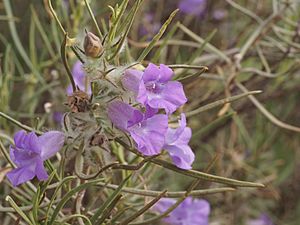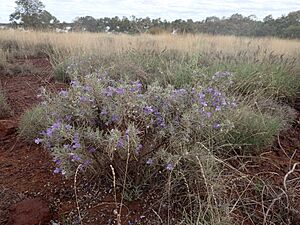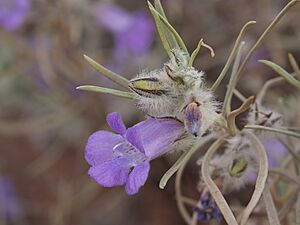Sandbank poverty bush facts for kids
Quick facts for kids Sandbank poverty bush |
|
|---|---|
 |
|
| E. margarethae leaves and flowers | |
| Scientific classification | |
| Genus: |
Eremophila (plant)
|
| Species: |
margarethae
|
The Eremophila margarethae, often called the sandbank poverty bush, is a special flowering plant. It belongs to the figwort family and grows only in Western Australia. This plant is a low, spreading shrub with grey leaves. Its flowers are usually pink or purple. You can find it commonly in the central parts of Western Australia.
Contents
What is the Sandbank Poverty Bush?
The Sandbank Poverty Bush is a shrub that spreads out, usually growing less than 1.5 m (60 in) (about 5 feet) tall. Its branches and leaves are covered with fine, soft grey or yellowish hairs.
Leaves and Stems
The leaves grow one after another along the branches. They are thick, especially near their edges. Their shape is like a narrow line or a spearhead, mostly 5–15 mm (0.2–0.6 in) (about 0.2 to 0.6 inches) long and 2.5–7 mm (0.1–0.3 in) (about 0.1 to 0.3 inches) wide. As the leaves get older, they develop a sticky coating called resin. This resin can sometimes hide the tiny hairs on the leaves. The main vein of the leaf sticks out on the bottom side and looks like a groove on the top.
Flowers and Fruits
The flowers grow either alone or in pairs where the leaves meet the stem. They sit on hairy stalks that are 3.5–7.5 mm (0.1–0.3 in) (about 0.1 to 0.3 inches) long. Each flower has five very hairy, dark purple, tapering parts called sepals, which are 7.5–13 mm (0.3–0.5 in) (about 0.3 to 0.5 inches) long.
The petals are 23–29 mm (0.9–1 in) (about 0.9 to 1.1 inches) long. They are joined together at their bottom to form a tube. The outside of this tube is pale to deep lilac in color. The inside is white with lilac or purple spots. The outside of the tube and the petal tips are hairy, but the inside of the tips is smooth. The inside of the tube is full of soft, woolly hairs. The four stamens (the parts that make pollen) are completely hidden inside the petal tube.
This plant flowers from April to October. After flowering, it produces oval-shaped fruits. These fruits have a smooth, straw-colored, papery covering and are 6–9 mm (0.24–0.35 in) (about 0.2 to 0.4 inches) long.

How it Got its Name
This plant was first officially described by a scientist named Spencer Le Marchant Moore in 1899. He published his description in a science journal called Journal of the Linnean Society, Botany.
The second part of its scientific name, margarethae, was chosen to honor Margaret Forrest. She was the wife of Sir John Forrest, a famous explorer and politician in Western Australia.
Where Does it Live?
The Sandbank Poverty Bush is very common and can be found in many places between Leonora and Newman in Western Australia. It grows in several different natural areas, including the Gascoyne, Little Sandy Desert, Murchison, and Pilbara regions.
It likes to grow in mulga woodlands. These are areas with many mulga trees. You can often find it on flat areas with hard soil, or sometimes on stony hills.
Its Role in Nature
The Sandbank Poverty Bush can tell us something important about the health of pastures (areas where animals graze). If you see a lot of this plant, it often means that the pasture has been overgrazed. This happens when too many animals eat too much grass, like broad-leaf wanderrie grass and buck wanderrie grass. The Sandbank Poverty Bush is not tasty to farm animals, so they don't eat it. This allows it to grow more when other plants are eaten down.
This plant can also be affected by a tiny insect called the hopbush scale insect (Pulvinaria dodonaeae). About 10% of these plants can be killed by this insect, even though other similar plants are not harmed.
Is it in Danger?
The Western Australian Government's Department of Parks and Wildlife has looked at the Sandbank Poverty Bush. They have officially said that it is "not threatened," which means it is not in danger of disappearing.
Growing Sandbank Poverty Bush
This plant is a small, tough shrub that looks great in gardens. Its silvery-grey leaves make a nice contrast with its blue flowers.
You can grow new plants from pieces of the stem (called cuttings). You can also grow it by grafting it onto the root system of another plant called Myoporum. It grows best in soil that drains water well and in a sunny spot. If it's in too much shade, it might grow a bit more openly. It can handle very dry conditions and is also quite good at surviving frost.


